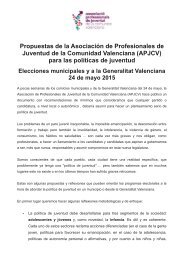c39dc
c39dc
c39dc
You also want an ePaper? Increase the reach of your titles
YUMPU automatically turns print PDFs into web optimized ePapers that Google loves.
terms of the returns that most individuals in Europe and the USA can<br />
expect from their skills 43 .<br />
An associated problem is the increase in young people disengaged<br />
both from education, employment and training (NEET), who in 2010<br />
amounted to over 12% of the population of 15-24 year-olds in the<br />
EU-27 - or around 7.5 million people. The European Foundation for<br />
the Improvement of Living and Working conditions estimated the<br />
costs of NEETs’ lack of participation in the labour market in 21<br />
countries at €100 billion per year, including foregone earnings and<br />
excess transfers. In addition to this, there are significant costs<br />
associated with the social and health costs of youth unemployment 44 .<br />
Employment, it must be kept in mind, is not only related to economic<br />
growth, competitiveness and individual returns. It is also a key<br />
mechanism for social inclusion. It can be an important element in<br />
shaping relational issues, social participation 45 and social<br />
integration 46 . This is more so when employment is of quality. As<br />
Atkinson notes, ‘marginal’ jobs (that lack continuity, training or<br />
possibilities of promotion) may be no solution in terms of social<br />
inclusion 47 . This is a crucial aspect to consider regarding the situation<br />
of young people, as this group is increasingly being caught in a cycle<br />
of temporary contracts and unpaid internships 48 .<br />
Higher skills development that leads to labour market integration can,<br />
then, aid social inclusion as well as economic competitiveness. Thus,<br />
education needs to go beyond purely instrumental considerations to<br />
provide people with the skills they need for active participation in<br />
society 49 and personal development. In both respects non-formal<br />
education has an important role to play 50 . The next subsection looks<br />
at different international perspectives and actions in this area.<br />
2.4 The Recognition of non-formal education and non-formal learning:<br />
international perspectives<br />
The above trends underline the importance of making all of young<br />
people’s learning visible, regardless of whether it has been acquired<br />
in formal, non-formal or informal settings, for economic and social<br />
43 Brown, P., Lauder, H. and Ashton, D. (2011) The global auction. New York, Oxford University Press.<br />
44 WHO-Europe, (2009) A Snapshot of the Health of Young People in Europe, Copenhagen; European Princes’ Trust<br />
(2009) YouGov Youth Index 2010. London.<br />
45 European Youth Forum (2005) Policy paper on ‘recognition of non-formal education: confirming the real<br />
competencies of young people in the knowledge society. Brussels, 11-12 November 2005.<br />
46 Room, G. (1995) Beyond the threshold: the measurement and analysis of social exclusion. Bristol, Policy Press.<br />
47 Atkinson, A. B. and Hills, J. (1998) Exclusion, employment and opportunity. CASE Paper 4, London School of<br />
Economics.<br />
48 European Youth Forum (2010) Position paper on Youth Guarantee. Antwerp, 2-3 September 2010.<br />
49 Council of Europe (2003) Study on the links between formal and non-formal education. Directorate of Youth and<br />
Sport, Strasbourg, March 2003.<br />
50 European Youth Forum (2006) Policy Paper on Equality and Diversity. Rotterdam, 13-15 November 2008.<br />
21




